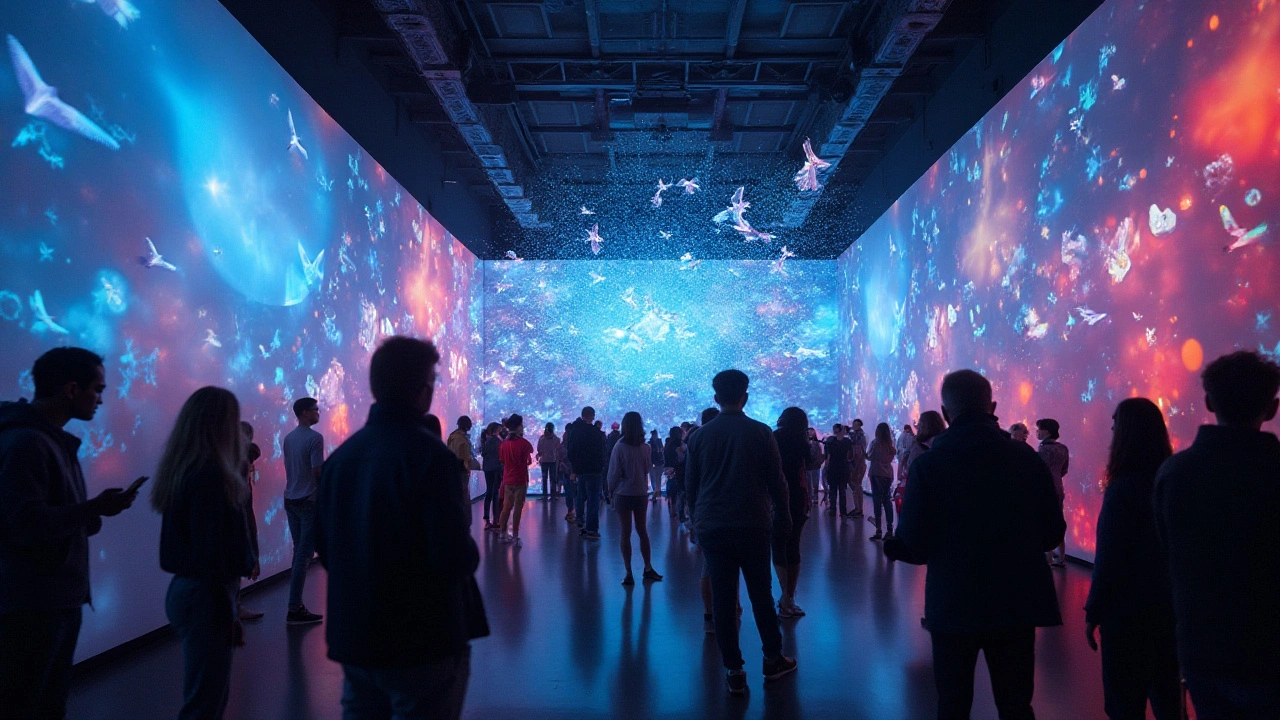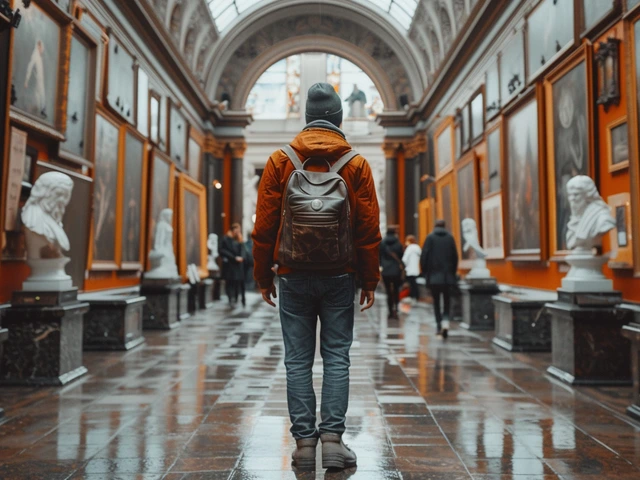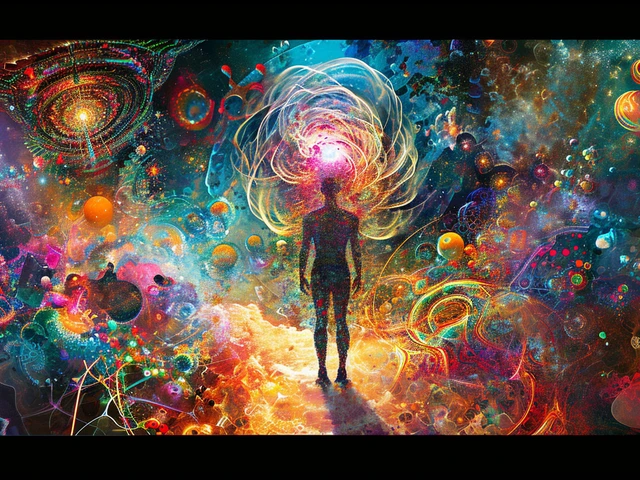The world of contemporary art thrives on innovation and a bold spirit that seeks to challenge conventions. Artists today are not just creators, but explorers venturing into uncharted territories, often using technology and new media to forge their path.
In an era defined by rapid change and digital expansion, contemporary art reflects the complexity of our lives while engaging with the pressing issues of our time. From thought-provoking installations to avant-garde paintings, this artistic genre serves as both a mirror and a lens—a reminder of who we are and an exploration of who we might become.
- The Evolution of Contemporary Art
- Innovative Techniques and Materials
- Breaking Traditional Boundaries
- Interactive and Digital Art
- Prominent Contemporary Artists
- The Future of Contemporary Art
The Evolution of Contemporary Art
Contemporary art has undergone a remarkable transformation from its early roots to the myriad forms it takes today. This dynamic field has continuously pushed the boundaries of creativity, adapting to cultural shifts and technological advancements. To truly understand how this evolution took place, we must look back to the late 20th century, a time when artists began to break away from traditional methods and styles, seeking new ways to express the complexities of modern life. The late 1960s and 1970s marked a significant turning point, particularly with the rise of conceptual art, which emphasized the idea behind the work as much as the work itself. Artists began using unconventional techniques and media—anything from found objects to readily accessible technology—to convey their messages.
"Art is not what you see, but what you make others see." - Edgar Degas
The evolution continued through the decades with movements such as postmodernism rejecting rigid structures and embracing eclecticism in art. During this time, art became more about questioning established norms, challenging societal conventions, and often shocking audiences out of their comfort zones. Artists like Andy Warhol and Jean-Michel Basquiat became icons for their ability to blend high and low culture, introducing popular themes into the fine art world. Their work proved transformative in reshaping public perceptions of what art could be and whom it spoke to. The integration of diverse cultural narratives and the embrace of social and political issues became a hallmark of contemporary expression.
As the digital age dawned, the impact on contemporary art was profound and irreversible. The rise of the Internet and digital technologies in the '90s and early 2000s offered new platforms for artists to experiment and reach broader audiences. Digital installations, video art, and virtual reality spaces became the tools of the modern artist. With platforms like Instagram, art became democratized—accessible to anyone with an internet connection. This fluidity changed the way we consume art and allowed for global and diverse voices to be heard and seen, leading to increased representation and dialogue among cultures. With artists leveraging these technologies, they not only expanded the toolkit available to them but also enhanced their storytelling capabilities.
Today, contemporary art continues to stand at the forefront of cultural discourse. It reflects the ever-changing world that we inhabit—molding and being molded by external factors. As society faces unprecedented challenges, from climate change to social justice issues, art remains a vital medium for highlighting these critical conversations. Artists today are environmental activists, cultural commentators, and innovators, breaking new ground with every stroke and installation. The constant redefinition of what art means and how it is consumed ensures that contemporary art remains relevant and cutting-edge, forever evolving yet always rooted in its rich history.
Innovative Techniques and Materials
In the vast realm of contemporary art, innovation knows no bounds. Artists continuously redefine what is possible, merging tradition with the avant-garde to craft pieces that mesmerize and provoke. This fusion is marked by the inventive use of techniques and materials, pushing the boundaries of traditional media like paint and canvas into bold, uncharted territories.
A prominent shift in this landscape is the embrace of digital technology. Today’s artists are adept at utilizing projection, virtual reality, and interactive installations to immerse viewers into a sensory experience unlike any other. For instance, the usage of 3D printing enables the creation of intricate sculptures that defy gravity and conventional geometry. These modern art techniques allow for precision and detail that were once inconceivable, offering a new dimension to the artistic narrative.
Organic materials are also making their mark. This shift towards sustainability sees artists crafting with recycled goods, reshaping what some might consider refuse into poignant expressions. Imagine a sculpture composed entirely of ocean debris, speaking volumes about environmental preservation. Such works not only reflect creativity but also societal commentary, blending aesthetics with advocacy.
Klaus Biesenbach of MoMA PS1 once noted, “Contemporary artists challenge our perception of reality. They pick the debris, literally and metaphorically, and turn it into art, into future.”
The use of unconventional media extends to bioluminescent materials, which glow in the dark, unearthing new possibilities for creating dynamic, living works of art. Coupling science with artistry, these materials bring forth a dialogue between nature and humanity. This synthesis of art and science keeps evolving, with biomimicry becoming a source of inspiration as artists study natural processes and emulate them in their creations.
An intriguing movement within this spectrum is the trend of augmented reality (AR) art. Through AR, artists superimpose digital information onto real-world environments. The result is a blended reality that invites viewers to engage both virtually and physically. This overlap between tangible and virtual worlds highlights the fluidity and versatility of creative expression in our technologically saturated age.
Amidst these innovations, it is essential to recognize that the heart of contemporary art remains unchanged in its commitment to express the human condition. Whether employing traditional methods or unprecedented technology, artists continue to ignite conversations, evoke emotions, and challenge perspectives. These pioneering endeavors animate the dynamic canvas of contemporary art, promising a future as vivid and varied as the present itself.
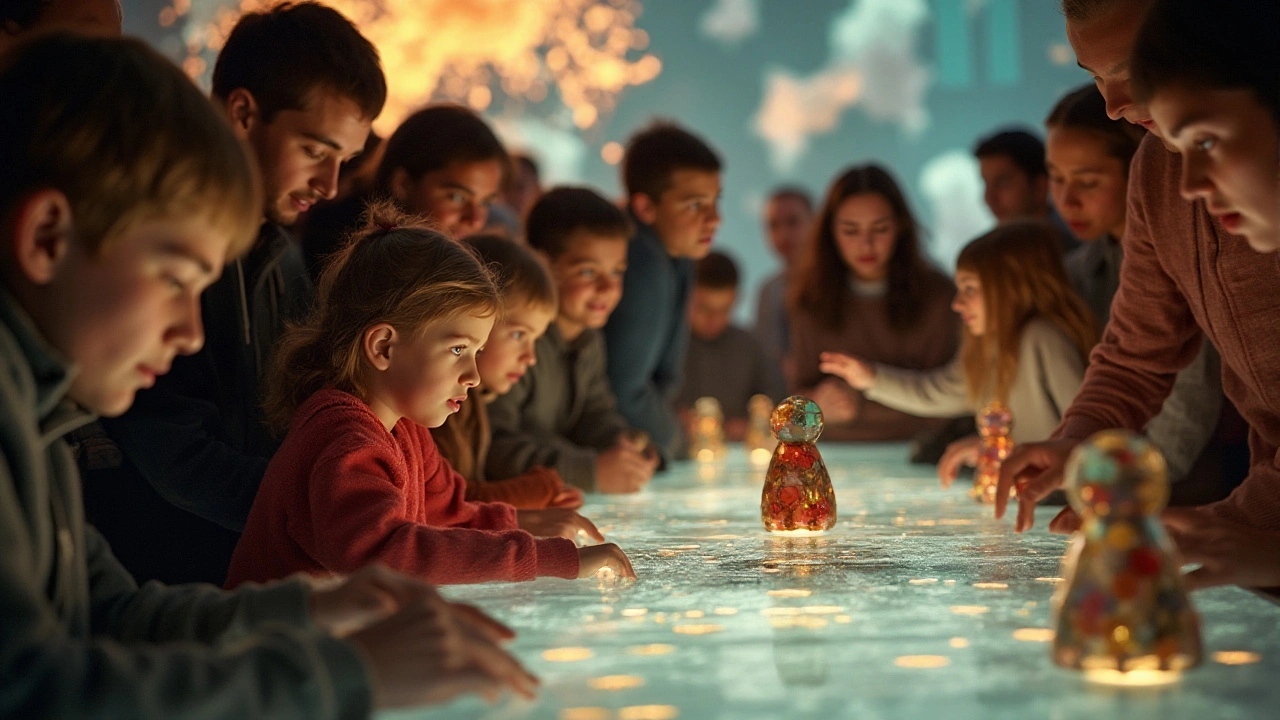
Breaking Traditional Boundaries
In the realm of contemporary art, breaking away from traditional confines is not just an occasional endeavor—it's practically a manifesto. Artists today ask bold questions, addressing everything from political issues to personal identity. Their works often serve as catalysts for dialogue, challenging the audience to see the world through a new lens. This desire to redefine artistic expression leads to the exploration of unconventional mediums, merging art with technology, and incorporating elements like sound, movement, and even interactivity.
One notable example is the use of virtual reality (VR) in art installations, where viewers are no longer spectators but participants, submerged in a digital landscape that can be as disorienting as it is exhilarating. This shift from the passive viewing of art to an active experience invites a deeper connection. A prime illustration of this was the 2019 Whitney Biennial exhibition where artists like Ian Cheng presented VR experiences, emphasizing the potential of digital landscapes.
It's also fascinating to note how artists are using their platforms to engage with socio-political settings. The contemporary art scene often challenges entrenched systems and traditions, shedding light on marginalized voices and fostering greater inclusivity. Many museums and galleries now recognize the power of art as a form of activism, transforming spaces into arenas for social change. In a 2020 TED talk, artist Theaster Gates said,
"Art has the power to transform spaces not just aesthetically, but to shift societal narratives and create pathways for dialogue and healing."
Moreover, interdisciplinary collaborations are blurring the lines between traditional art forms. Artists team up with scientists, architects, and engineers to create immersive and thought-provoking projects. In 2021, a UNESCO report highlighted that over 40% of contemporary artists had engaged in interdisciplinary collaborations, lending further credence to the notion that traditional boundaries are becoming increasingly irrelevant in the modern art scene.
Artists like Olafur Eliasson blur the boundary between art and architecture, creating pieces that require audience interaction and participation. His work often draws on natural elements like light, shadows, and reflections, which prompts viewers to think about their relationship with the natural environment. Not constrained by traditional artistic spaces, Eliasson often exhibits in public areas, thereby inviting a broader audience to engage with his work.
What's more, the integration of ecological themes in art underscores a growing urge to use creativity as a force for environmental advocacy. Modern artists are increasingly partaking in eco-conscious projects, using recycled materials or crafting art that addresses environmental issues. This movement not only highlights a profound respect for our planet but also inspires audiences to reconsider their own role in the broader ecological narrative. As society grapples with climate change, art becomes a voice of concern, hope, and oftentimes, a call to action.
Interactive and Digital Art
In the ever-evolving sphere of contemporary art, the integration of interactive and digital elements has dramatically altered the way audiences engage with art. No longer confined to static, untouchable pieces, modern art now invites viewers to become participants rather than mere observers. This shift has been largely driven by advances in technology, offering artists a new toolkit for creativity. Interactive art pieces often incorporate digital components, requiring the viewer to engage through movement, touch, or even through their smartphones. This blurring of boundaries between the artwork and the audience breathes new life into traditional art forms, offering experiences that are as thought-provoking as they are memorable.
One of the remarkable aspects of digital art is its ability to blend visual elements with sound, motion, and interactivity. This combination can create a multisensory experience that fully immerses the participant. Whether by using virtual reality or augmented reality technologies, artists are now able to create spaces where art becomes a living, breathing entity that responds to and evolves with its viewers. For instance, in an installation aptly named "Rain Room" by Random International, visitors walk through simulated rain inside a gallery space without getting wet due to sensors predicting and blocking the rain where people step. Such installations highlight the transformative potential of contemporary art.
Noteworthy Examples and Their Impact
Artists like Olafur Eliasson have taken the art world by storm by incorporating digital techniques to craft immersive environments, eliciting visceral reactions from their audiences. Eliasson's 'The Weather Project', exhibited in Tate Modern, ingeniously employed light, smoke, and mirrors to simulate an indoor sun that filled the vast hall, prompting viewers to reflect on their place within the cosmos. As renowned art curator Léontine Meijer-van Mensch aptly said, "In the landscape of contemporary art, interaction is not merely desired but essential; it transforms passive observation into dynamic participation."
The influence of technology on art extends beyond interactive installations into the digital arena with the surge of NFT (Non-Fungible Token) art, transforming the way we view ownership and distribution in the art world. This innovation has opened up a previously unimaginable market for digital artists, allowing them to sell unique digital creations directly to collectors, circumventing traditional art galleries. With this, artists have gained newfound financial independence and flexibility. The popularity of NFTs was underscored when digital artist Beeple sold an NFT artwork for $69 million at a Christie's auction, marking a watershed moment in art and digital culture history.
As we delve deeper into this era where the digital landscape reshapes artistic expression, it's crucial to appreciate the seamless integration of creativity and technology. This fusion not only challenges the way art is produced and consumed but also democratizes access, allowing broader audiences to experience and engage with art in unprecedented ways. Whether the future holds more technological integration into the arts, or a return to simpler forms, the impact of interactive and digital art is undeniable, continuously pushing the boundaries of creative expression.
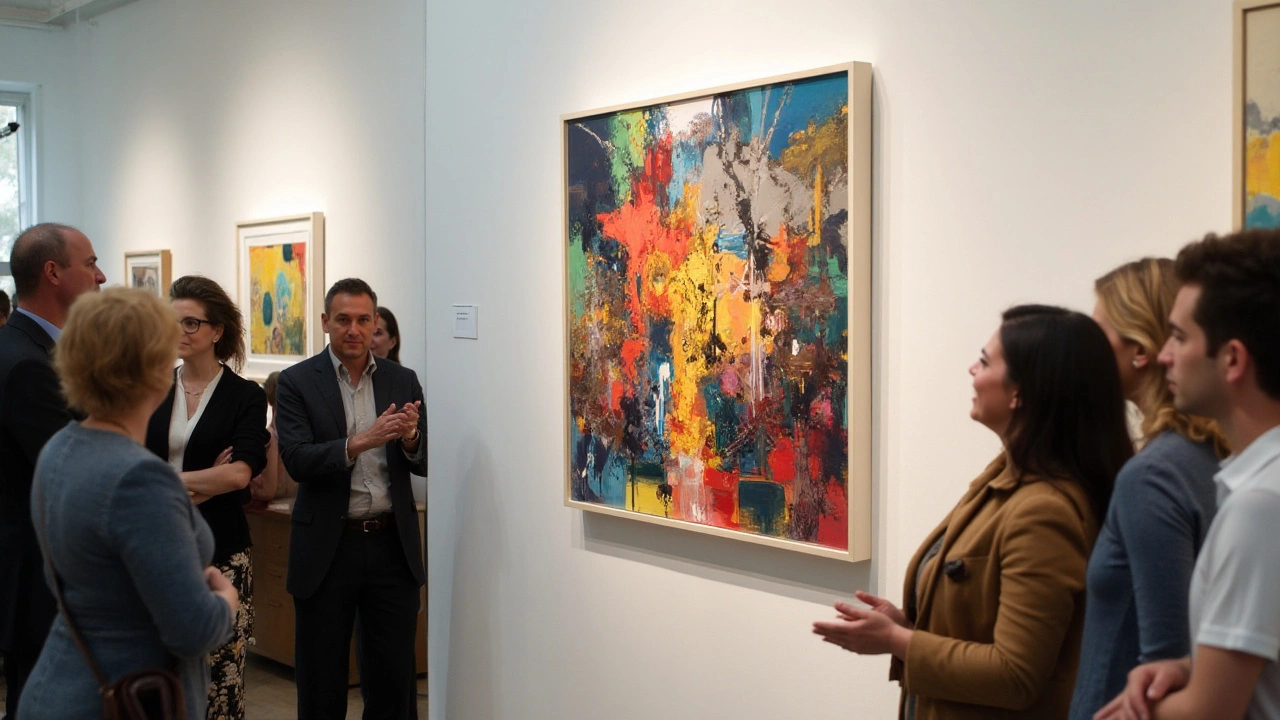
Prominent Contemporary Artists
Contemporary art has given rise to a myriad of talented artists who are shaping the 21st-century aesthetic with their imaginative exploration of form and subject. Among these, Banksy stands as a beacon of subversive expression in the urban art movement. Known for his satirical street art, Banksy's work often tackles political themes and critiques societal issues. His anonymity only adds to the intrigue and impact of his pieces, turning city streets into open galleries. In the context of modern art discourse, Banksy is a name that consistently provokes thought and discussion. Another key figure is Yayoi Kusama, whose incredible journey from a small painting studio in Japan to being celebrated worldwide is both inspiring and significant. Her psychedelic visions and signature polka dots offer one an immersive experience that blurs the lines between art and audience, essentially inviting the observer into a different realm altogether.
Art is an evolving conversation, and artists like Kusama have always stuck to their roots while responding to contemporary issues. Refik Anadol is another artist redefining the contemporary landscape with his digital installations that merge virtual and physical environments. His work, inspired by data and algorithms, illustrates a future where art and technology go hand in hand. Anadol reimagines architecture as a dynamic form of art, transforming static structures with his light and color projections. Artists such as he are not just creating art; they are pioneers exploring the interactive and digital art frontier. Additionally, the works of Ai Weiwei represent a bold narrative of resistance and activism. His outspoken criticism of the Chinese government paired with his deliberate use of traditional Chinese materials and techniques makes a powerful statement in today’s world. Ai Weiwei’s art forces viewers to confront their preconceived notions about freedom and authority while emphasizing the integrity of his cultural heritage.
In examining the methodologies these figures employ, one sees a clear pattern of both innovation and respect for artistic traditions. These prominent contemporary artists have mastered the delicate balance of pushing boundaries while maintaining relevance in their chosen mediums. A noteworthy mention must also go to El Anatsui, whose work redefines the potential for recycled materials in fine art. His use of bottle caps and other discarded items woven into large-scale installations highlights issues of environmentalism while celebrating African cultural identity. Through his hands, what were once mundane objects become extraordinary tapestries, drawing attention to both their beauty and the narrative of consumption they represent. It’s in these recyclings and reimaginings that Anatsui sets the stage for a discourse on sustainability as part of the contemporary art dialogue.
"From chaos, Anatsui creates mesmerizing pieces that transcend the boundary between waste and wonder, challenging us to see value in what we discard." - Art Critic Review
The Future of Contemporary Art
As we peer into the horizon, contemporary art stands as a testament to creative evolution—a movement that defies traditional boundaries while embracing technological advances and shifting cultural paradigms. The future of this dynamic field seems poised to harness the pulse of current innovations, particularly in realms such as digital art, virtual reality, and artificial intelligence. These areas not only augment the artist's toolkit but offer audiences novel ways to experience art.
Digital platforms, for instance, are significantly reshaping how we perceive and distribute modern art. With the advent of blockchain technology, artists now have new avenues to authenticate and sell their works through NFTs (non-fungible tokens), adding a financial dimension that was previously unavailable. This growing trend not only democratizes artistic endeavors, allowing emerging artists to gain visibility, it also expands the concept of what constitutes an art piece—beyond the physical, embracing the digital realm.
Another exciting prospect lies within the sphere of interactive art, where audiences no longer just observe but participate, blurring the lines between creator and viewer. This engagement fosters a deeper connection to the artwork, transforming traditional spectatorship into an immersive experience. Inevitable are instances like Caitlin Fisher's interactive works which incorporate augmented reality, enabling users to navigate through evolving narratives.
With technology pushing the boundaries, some artists surmise how AI might revolutionize creative expression. This notion is not just speculative; it’s happening now. AI-generated art is fast carving a niche, challenging our understanding of originality and creativity. Artists, such as Mario Klingemann, employ AI algorithms to produce pieces that elicit questions about human versus machine ingenuity. A fascinating question arises: will machines eventually co-create with humans, or even independently generate pieces hailed as masterpieces?
"The future of art is not in questioning whether machines will make art, but in exploring what kinds of new art will emerge through human-machine collaborations," says Anna Ridler, a well-known artist and researcher.
Art institutions, too, are reimagining their roles. Moving beyond guardians of art history, they are becoming facilitators for contemporary discourse. Museums and galleries are establishing virtual exhibitions, making art accessible to a global audience irrespective of physical constraints. Emerging talent centers and collectives are fostering new voices, exploring what the art world may resemble if inclusivity becomes paramount.
As the world contemplates the art of tomorrow, it remains clear that the essence of contemporary art thrives on its ability to evolve continually. This fluidity not only affirms its relevance but promises to keep challenging our perspectives while captivating our imaginations. The future is undoubtedly bright, bold, and profoundly inspiring—much like contemporary art itself.

